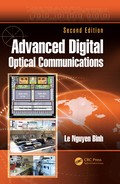Preface
The trends in long-haul terrestrial and intercontinental telecommunications systems and networks are toward longer transparent distance and increased information capacity with cost-effective implementation of the communications systems.
One of the possibilities is the use of modulation formats and coherent reception incorporating digital signal processors (DSPs), analog-to-digital converters (ADCs), and digital-to-analog converters (DACs) providing a sampling rate of 120 GSa/s rather than the on–off keying intensity modulation and direct detection traditionally employed in current optical communications networks; that is, the use of the amplitude, phase, and frequency of the lightwave carrier and formats of return-to-zero and non-return-to-zero with and without suppression of the carrier to represent the information for effective transmission. These modulation formats must be robust to noise, distortion, and nonlinear impairments and have high spectral efficiency. The DSP operating at an extremely high speed allows system engineers to overcome several problems in the reception subsystems of the coherent transmission technology initiated in the 1980s.
Thus, we have been witnessing the merging of the fields of digital communications and optical communications in advanced transmission techniques for long-haul optically amplified communications in global systems networks. Furthermore, the DSP-coherent reception techniques with polarization multiplexing and complex modulation schemes have pushed the current optical transmission technology to a new generation, with bit rates of 100G and beyond deployed extensively in several terrestrial and undersea telecommunications networks as well as in metropolitan and access networking environments. Therefore, in this book, digital modulation techniques are applied to optical communications systems, including binary and quadrature amplitude shift keying, phase shift keying, differential shift keying, continuous phase shift keying, frequency shift keying, and multilevel modulation as well as the use of multi-subcarriers such as orthogonal frequency division multiplexing. Both coherent and self-coherent reception techniques are described in this second edition, whereas only the latter technique was treated in the previous edition.
Further, the formats of the modulation with return-to-zero or non-return-to-zero and suppression of carrier can be employed so as to minimize the contribution of the carrier energy, to combat the nonlinear impairment with the enhancement of the energy contained within the signal spectra. Furthermore, with the advances in digital signal processing with a high sampling rate, lightwavemodulated signals can be detected coherently to recover the phase of the signals and then processed via DSPs. Thus, we have now witnessed the revival of coherent communications, which was developed during the 1980s to improve the optical signal to noise ratio for extending the repeaterless distance, before optical amplifiers made their appearance.
The modulation and transmission are treated theoretically, experimentally, and by simulation. MATLAB® and Simulink® is extensively described in the chapters as this modeling platform is now universally available in research laboratories in industries and universities around the world. So it is expected that the models provided in this book will assist researchers and engineers in further developing specific optical communications systems employing new modulation formats in MATLAB and Simulink is preferred as the software package within MATLAB because it is based on block sets, thus resulting in ease of use and shortening of learning and development time. The use of MATLAB and Simulink would require users to understand the principles of digital communications with various communications and mathematical blocks. There are no such optical communications block sets in MATLAB and Simulink, so one of the main objectives of this book is to provide the operational principles of optical communications blocks as examples for users who wish to model their systems.
The objectives of the book are (1) to describe the principles of digital communications within the context of optical and photonic transmission technology; (2) to present the advanced optical transmission of various digital modulation formats over optically amplified fiber links within the contexts of experiment, theory, and modeling; and (3) to identify the roles of the frequency spectra of digital modulation formats for effective transmission of signals, to combat transmission impairments, and to increase the communications capacity.
This book, Advanced Digital Optical Communications, is the second edition of the book Digital Optical Communications that was published in 2008 [1]. It has extensive chapters treating modern aspects of coherent homodyne reception techniques using algorithms incorporated in DSP systems and DSP-based transmitters to overcome several transmission linear and nonlinear impairments and frequency mismatching between the local oscillator and the carrier as well as clock recovery and cycle slips. The differences between the two editions of the book are given in Chapter 1.
The author can be contacted via [email protected].
Reference
1. L. N. Binh, Digital Optical Communications, Boca Raton, FL: CRC Press, 2008.
MATLAB® is a registered trademark of The MathWorks, Inc. For product information, please contact:
The MathWorks, Inc.
3 Apple Hill Drive
Natick, MA 01760-2098 USA Tel: 508 647 7000
Fax: 508-647-7001
E-mail: [email protected]
Web: www.mathworks.com
For information on samples of MATLAB and Simulink models and problem solving techniques, especially problems given at the end of a number of chapters refer to www.crcpress/products/ISBN9781482226522.com
